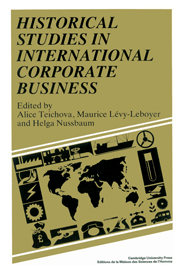Book contents
- Frontmatter
- Contents
- Preface
- 1 Introduction: multinational enterprise
- 2 History, the social sciences and economic ‘theory’, with special reference to multinational enterprise
- 3 The changing form of multinational enterprise expansion in the twentieth century
- 4 Electrical research, standardisation and the beginnings of the corporate economy
- 5 The nature of multinationals, 1870–1939
- 6 International price maintenance: control of commodity trade in the 1920s
- 7 Financial operations of US transnational corporations: development after the Second World War and recent tendencies
- 8 Multinational enterprise – financing, trade, diplomacy: the Swedish case
- 9 Foreign penetration of German enterprises after the First World War: the problem of Überfremdung
- 10 International industrial cartels, the state and politics: Great Britain between the wars
- 11 Vickers and Schneider: a comparison of new British and French multinational strategies 1916–26
- 12 J. & P. Coats Ltd in Poland
- 13 Multinationals and the French electrical industry, 1889–1940
- 14 The Japanese cotton spinners' direct investments into China before the Second World War
- 15 Mitsui Bussan during the 1920s
- 16 Japanese business in the United States before the Second World War: the case of Mitsui and Mitsubishi
- 17 The state and private enterprise in the United States–Latin American oil policy
- 18 Transnational corporations and the denationalization of the Latin American cigarette industry
- 19 Summary: Reflections on the papers and the debate on multinational enterprise: international finance, markets and governments in the twentieth century
- Index of names
- Index of firms
- Index of subjects
15 - Mitsui Bussan during the 1920s
Published online by Cambridge University Press: 04 August 2010
- Frontmatter
- Contents
- Preface
- 1 Introduction: multinational enterprise
- 2 History, the social sciences and economic ‘theory’, with special reference to multinational enterprise
- 3 The changing form of multinational enterprise expansion in the twentieth century
- 4 Electrical research, standardisation and the beginnings of the corporate economy
- 5 The nature of multinationals, 1870–1939
- 6 International price maintenance: control of commodity trade in the 1920s
- 7 Financial operations of US transnational corporations: development after the Second World War and recent tendencies
- 8 Multinational enterprise – financing, trade, diplomacy: the Swedish case
- 9 Foreign penetration of German enterprises after the First World War: the problem of Überfremdung
- 10 International industrial cartels, the state and politics: Great Britain between the wars
- 11 Vickers and Schneider: a comparison of new British and French multinational strategies 1916–26
- 12 J. & P. Coats Ltd in Poland
- 13 Multinationals and the French electrical industry, 1889–1940
- 14 The Japanese cotton spinners' direct investments into China before the Second World War
- 15 Mitsui Bussan during the 1920s
- 16 Japanese business in the United States before the Second World War: the case of Mitsui and Mitsubishi
- 17 The state and private enterprise in the United States–Latin American oil policy
- 18 Transnational corporations and the denationalization of the Latin American cigarette industry
- 19 Summary: Reflections on the papers and the debate on multinational enterprise: international finance, markets and governments in the twentieth century
- Index of names
- Index of firms
- Index of subjects
Summary
Introduction
The decade of the 1920s was an era of great difficulties for trading companies in Japan. A number of large trading firms became insolvent: Mogi Shōten, Furukawa Shōji and Kuhara Shōji during the crisis of 1920; Takada Shōkai in 1925; and Suzuki Shōten during the financial panic of 1927 were representatives. Moreover, even those trading firms which barely escaped bankruptcy often suffered severely from widely fluctuating incomes which accompanied losses in the worst situation or from stagnating at low income levels as shown for the firms excluding Mitsui Bussan in table 15.1. However, in what was a period of hardships for most trading firms, Mitsui Bussan performed exceptionally well, continuously attaining high profit rates. Its profit rate, as shown in table 15.1, remained almost constant at around 15%, and stood out in sharp contrast to the movement and the level of other traders' profit rates. The purpose of this chapter is to look into the factors behind the superb managerial performance of Mitsui Bussan during the 1920s.
The characteristic features of Mitsui Bussan's commodity transactions
The close relationship between its commodity transactions and key industries
Mitsui Bussan was not a mere trading company but also was active in sideline businesses such as marine transportation, shipbuilding, agencies for ocean transport and insurance, and was rapidly taking on the characteristics of a holding company at this time.
- Type
- Chapter
- Information
- Historical Studies in International Corporate Business , pp. 163 - 176Publisher: Cambridge University PressPrint publication year: 1989



